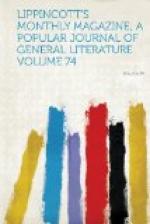Lady Moira, who so kindly befriended Lady Edward, was unquestionably a very remarkable woman, and had considerable influence, politically and socially, in the Dublin of her day. Although an Englishwoman, she became in some respects ipsis Hibernis Hibernior, and for a very long period prior to her death never quitted the soil of Ireland. Had the Irish aristocracy generally been of the complexion of those who assembled in the more intimate reunions at Moira House, the history of that country during the past century would have been a widely different one. The members of that brilliant circle were thorough anti-Unionists, and Lord Moira and his sons-in-law, the earls of Granard and Mountcashel, proved that they were not to be conciliated by bribes, either in money or honors, by entering their formal protest against that measure on the books of the Irish House of Lords.
When the delegates on behalf of Catholic claims came to London in 1792, it was this enlightened Irish nobleman who received them, and who, in the event of the minister declining to admit them, intended as a peer to have claimed an audience of the king. Lord Moira both in the English and Irish Houses of Peers denounced the oppressive measures of the government, and his opposition gave so much offence that the English general Lake was reported to hayer declared that if a town in the North was to be burnt, they had best begin with Lord Moira’s, causing him so much apprehension that he removed his collection, which was of extraordinary value, from his seat, Moira Hall, in the county Down, to England.
The celebrated John Wesley visited Lady Moira at Moira House in 1775, “and was surprised to observe, though not a more grand, a far more elegant room than he had ever seen in England. It was an octagon, about twenty feet square, and fifteen or sixteen high, having one window (the sides of it inlaid throughout with mother-of-pearl) reaching from the top of the room to the bottom: the ceiling, sides and furniture of the room were equally elegant.” It was here that two of the greatest members of their respective legislatures—Charles Fox and Henry Grattan—first met in 1777, and Moira House continued to be the scene of splendid entertainments up to the death of the first Lord Moira, in 1793. Wesley concludes his letter about Moira House by asking, “Must this too pass away like a dream?” Whether like a dream or no, it certainly has been signally the fate of this whilom proud mansion to pass from the highest to the very humblest almost at a bound. For some years after Lady Moira’s death (in 1808) the house was kept up by the family, but in 1826 it was let to an anti-mendicity society. The upper story was removed, the mansion was stripped throughout of its splendid decorations—some of the furniture is now at Castle Forbes, the seat of the earl of Granard, Lady Moira’s great-grandson, a worthy descendant—and the saloons which were wont to be thronged with the most brilliant and splendid society of the Irish metropolis in its heyday are now the abode of perhaps the very poorest outcasts who are to be found in the whole wide world.




